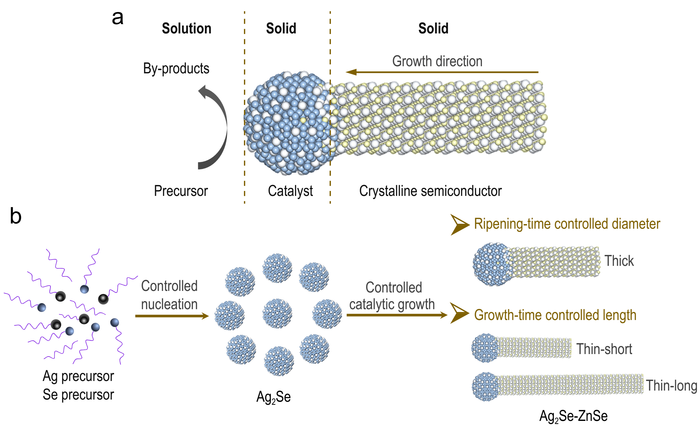Reviewed by Alex SmithApr 11 2022
Quantum wires (QWs) are one-dimensional semiconductor nanowires with a strong quantum confinement effect that have applications in sophisticated optoelectronics and photochemical conversions. Far beyond the robust Cd-containing QWs, ZnSe QWs have demonstrated great potential for next-generation environmentally friendly applications as a representative heavy-metal-free semiconductor.
 (a) The solution-solid-solid growth mechanism. (b) Two-step catalyzed growth for independent radial and axial size control of ZnSe QWs. Image Credit: ©Science China Press.
(a) The solution-solid-solid growth mechanism. (b) Two-step catalyzed growth for independent radial and axial size control of ZnSe QWs. Image Credit: ©Science China Press.
The majority of ZnSe nanowires currently available are either in the strong quantum confinement regime with near-ultraviolet light absorption or in the bulk regime with undetectable exciton features. Concurrent, on-demand and high-precision manipulations of their radial and axial sizes—which allows strong quantum confinement in the blue-light region—have proven difficult to achieve thus far, limiting their potential applications.
A research group headed by professor YU Shuhong at the University of Science and Technology of China (USTC) has disclosed the on-demand synthesis of high-quality, blue-light-active ZnSe QWs by constructing a flexible synthetic approach—a two-step catalytic growth strategy that allows highly accurate, independent and broad controls over the diameter and length of ZnSe QWs.
The researchers reduced the gap between previous magic-sized ZnSe QWs and bulk-like ZnSe nanowires in this way. The study was published in the National Science Review journal.
The scientists discovered that a new epitaxial orientation between cubic-phase catalyst tips and wurtzite ZnSe QWs promotes the formation of ultrathin, stacking-fault-free QWs kinetically.
Their well-defined, ultranarrow excitonic absorption in the blue-light region with an entire width at half maximum (FWHM) of sub-13 nm is due to high-degree size control, strong quantum confinement, and the absence of mixed phases. They excluded surface electron traps in these ZnSe QWs after surface thiol passivation, resulting in long-lived charge carriers and high-efficiency solar-to-H2 conversion.
For a wide range of colloidal nanowires, the two-step catalyzed growth model is thought to be general. Access to those high-quality nanowires would therefore provide a multifunctional material library for applications in solar fuels and optoelectronics that do not require heavy metals.
Journal Reference:
Li, Y., et al. (2022) On demand defining high-quality, blue-light-active ZnSe colloidal quantum wires. National Science Review. doi.org/10.1093/nsr/nwac025.